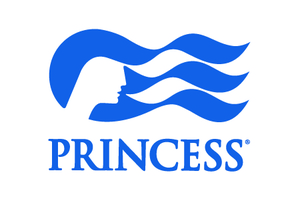
Price based on lowest available cruise only fare for double occupancy. Subject to change at any time.
Sun Princess® leads our next generation of ships
What Were We Thinking of When We Designed the New Sun Princess? You.
We pondered everything, so you can feel the love on the cruise vacation of your dreams.
Because here, the sun revolves around you.
Cruise ID: 20719
To simplify the tipping process for our passengers, a discretionary gratuity charge will be automatically added to your shipboard account on a daily basis. The daily gratuity amounts are $16.50 per guest for suites, $15.50 per guest for mini-suites and club class, and $14.50 per guest for interior, oceanview, and balcony staterooms. This gratuity will be shared amongst those staff who have helped provide and support your cruise experience, including all waitstaff, stateroom stewards, buffet stewards, and housekeeping staff across the fleet. A 18% gratuity is added to bar charges and dining room wine accounts.
| Date | Time | Price * | Booking |
|---|---|---|---|
| 14 September 2024 | 17:00 | €1,806 | Call us to book |
* Price based on lowest available cruise only fare for double occupancy. Subject to change at any time.

Our Most Affordable Option for Guests Who Just Want a Comfortable Spot to Recharge
An interior is the perfect place to recharge your batteries. Our most affordable option, these staterooms feature two twin beds or a queen-size bed and the basic amenities you expect, from flat-panel TV to in-room refrigerator.
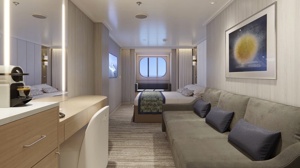
A Room With an Expansive View
Whether the calm of the deep blue sea or the adventure of a new city on the horizon, the Premium Oceanview stateroom ensures picture-perfect snapshots from the comfort of your room. This stateroom includes all the amenities of an interior room and the added benefit of ocean views that bring an airy openness to the space.
?3rd/4th berths available in select cabins.
†Guests may call for room service delivery or order through OceanNow® in the Princess® Cruises app at any time of the day or night. Guests with the latest Princess Plus and Princess Premier packages enjoy OceanNow® and room service delivery with no charge. Otherwise, a one-time access fee of $14.99 USD per person per voyage will apply for OceanNow® delivery and a $5 USD room service fee will apply for each order placed by stateroom phone. Limitations, restrictions and conditions apply.

The Most Relaxing Accommodations at Sea
Surrounding you with deluxe accommodations, a spacious Signature Penthouse Suite with balcony includes all the amenities of our Signature Collection, including access to the Signature Restaurant, Signature Lounge and Signature Sun Deck, a private area of The Sanctuary. Enjoy more living space, a separate seating area with sofa bed, enhanced amenities that range from priority embarkation and disembarkation to a complimentary mini-bar setup in suite and so much more.
In addition to premium stateroom amenities, Signature Collection suites include access to the Signature Restaurant, Signature Lounge and Signature Sun Deck, a private area of the Sanctuary.
? 3rd/4th berths available in select cabins.
‡ Separate tubs are available in Signature Sky Suites, Signature Owner's Suites and Signature Penthouse Suites.
† Guests may call for room service delivery or order through OceanNow® in the Princess® Cruises app at any time of the day or night. Guests with the latest Princess Plus and Princess Premier packages enjoy OceanNow® and room service delivery with no charge. Otherwise, a one-time access fee of $14.99 USD per person per voyage will apply for OceanNow® delivery and a $5 USD room service fee will apply for each order placed by stateroom phone. Limitations, restrictions and conditions apply.
^ Applicable on cruises six days or longer. Reservations can be made once onboard your ship.
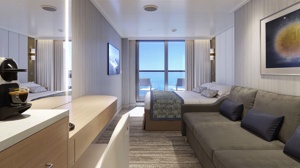
A Front Row Seat for Beautiful Scenery
This inspired stateroom offers the added indulgence of a private balcony with well-appointed outdoor furniture and a relaxing view of the scenery that surrounds you, whether a rainbow-colored sunset over the ocean or a new city to explore. It's also the perfect setting for cocktails before dinner or a leisurely breakfast.
?3rd/4th berths available in select cabins.
†Guests may call for room service delivery or order through OceanNow® in the Princess® Cruises app at any time of the day or night. Guests with the latest Princess Plus and Princess Premier packages enjoy OceanNow® and room service delivery with no charge. Otherwise, a one-time access fee of $14.99 USD per person per voyage will apply for OceanNow® delivery and a $5 USD room service fee will apply for each order placed by stateroom phone. Limitations, restrictions and conditions apply.
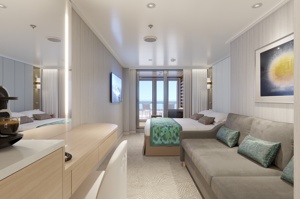
Treat Yourself Every Time You Walk Into Your Stateroom
A complimentary glass of bubbly isn't the only perk you enjoy when you choose a Mini-Suite. It's substantially larger than a balcony stateroom and includes a separate seating area with sofa bed as well as two flat-panel TVs. Need a little extra space for your family or group? A Mini-Suite is the option for you. Enjoy Reserve Collection upgrades on select Mini-Suites. In addition to the great amenities found in all Mini-Suites, you will receive Reserve Collection upgrades, including access to the Reserve Collection Restaurant.
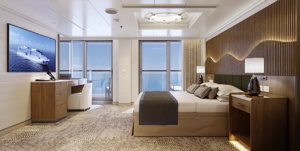
Our largest, most premium stateroom with accommodations for up to five guests
The exceptional features of a Signature Sky Suite include luxurious appointments, an expansive stateroom and balcony featuring two bedrooms, two bathrooms, one with a full bath with tub and separate shower, a seating area and sofa bed. Along with special suite-only benefits, this stateroom includes access to the Signature Restaurant, Signature Lounge and private Signature area of The Sanctuary.
In addition to premium stateroom amenities, Signature Collection suites include access to the Signature Restaurant, Signature Lounge and Signature Sun Deck, a private area of the Sanctuary.
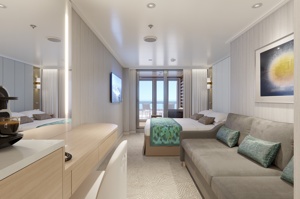
Enjoy Breathtaking Views in This Resort-Style Stateroom
The Cabana stateroom features a balcony, a private cabana, unique outdoor furniture and an extra-large private lounge space that lets you take in the fresh sea air. Unwind inside with a separate sitting area with sofa bed and premium bathroom amenities. Enjoy Reserve Collection upgrades on select Cabana Mini-Suites. In addition to the great amenities found in all Cabana Mini-Suites, you will receive Reserve Collection upgrades, including access to the Reserve Collection Restaurant.
Day 1 Barcelona, Spain
The infinite variety of street life, the nooks and crannies of the medieval Barri Gòtic, the ceramic tile and stained glass of Art Nouveau facades, the art and music, the throb of street life, the food (ah, the food!)—one way or another, Barcelona will find a way to get your full attention. The capital of Catalonia is a banquet for the senses, with its beguiling mix of ancient and modern architecture, tempting cafés and markets, and sun-drenched Mediterranean beaches. A stroll along La Rambla and through waterfront Barceloneta, as well as a tour of Gaudí's majestic Sagrada Famíliaand his other unique creations, are part of a visit to Spain's second-largest city. Modern art museums and chic shops call for attention, too. Barcelona's vibe stays lively well into the night, when you can linger over regional wine and cuisine at buzzing tapas bars.
Day 2 Palma de Mallorca, Spain
If you look north of the cathedral (La Seu, or the seat of the bishopric, to Mallorcans) on a map of the city of Palma, you can see around the Plaça Santa Eulàlia a jumble of tiny streets that made up the earliest settlement. Farther out, a ring of wide boulevards traces the fortifications built by the Moors to defend the larger city that emerged by the 12th century. The zigzags mark the bastions that jutted out at regular intervals. By the end of the 19th century, most of the walls had been demolished; the only place where you can still see the massive defenses is at Ses Voltes, along the seafront west of the cathedral.A torrent (streambed) used to run through the middle of the old city, dry for most of the year but often a raging flood in the rainy season. In the 17th century it was diverted to the east, along the moat that ran outside the city walls. Two of Palma's main arteries, La Rambla and the Passeig d'es Born, now follow the stream's natural course. The traditional evening paseo (promenade) takes place on the Born.If you come to Palma by car, park in the garage beneath the Parc de la Mar (the ramp is just off the highway from the airport, as you reach the cathedral) and stroll along the park. Beside it run the huge bastions guarding the Almudaina Palace; the cathedral, golden and massive, rises beyond. Where you exit the garage, there's a ceramic mural by the late Catalan artist and Mallorca resident Joan Miró, facing the cathedral across the pool that runs the length of the park.If you begin early enough, a walk along the ramparts at Ses Voltes from the mirador beside the cathedral is spectacular. The first rays of the sun turn the upper pinnacles of La Seu bright gold and then begin to work their way down the sandstone walls. From the Parc de la Mar, follow Avinguda Antoni Maura past the steps to the palace. Just below the Plaça de la Reina, where the Passeig d'es Born begins, turn left on Carrer de la Boteria into the Plaça de la Llotja (if the Llotja itself is open, don't miss a chance to visit—it's the Mediterranean's finest Gothic-style civic building). From there stroll through the Plaça Drassana to the Museu d'Es Baluard, at the end of Carrer Sant Pere. Retrace your steps to Avinguda Antoni Maura. Walk up the Passeig d'es Born to Plaça Joan Carles I, then right on Avenida de La Unió.
Day 3 Cartagena, Spain
A Mediterranean city and naval station located in the Region of Murcia, southeastern Spain, Cartagena's sheltered bay has attracted sailors for centuries. The Carthaginians founded the city in 223BC and named it Cartago Nova; it later became a prosperous Roman colony, and a Byzantine trading centre. The city has been the main Spanish Mediterranean naval base since the reign of King Philip II, and is still surrounded by walls built during this period. Cartagena's importance grew with the arrival of the Spanish Bourbons in the 18th century, when the Navidad Fortress was constructed to protect the harbour. In recent years, traces of the city's fascinating past have been brought to light: a well-preserved Roman Theatre was discovered in 1988, and this has now been restored and opened to the public. During your free time, you may like to take a mini-cruise around Cartagena's historic harbour: these operate several times a day, take approximately 40 minutes and do not need to be booked in advance. Full details will be available at the port.
Day 4 Cruising
Day 5 Cádiz, Spain
Believed to be the oldest town on the Iberian Peninsula, the Andalusian port of Cádiz enjoys a stunning location at the edge of a six-mile promontory. The town itself, with 3,000 years of history, is characterised by pretty white houses with balconies often adorned with colourful flowers. As you wander around be sure to take a stroll through the sizeable Plaza de Espãna, with its large monument dedicated to the first Spanish constitution, which was signed here in 1812. Cádiz has two pleasant seafront promenades which boast fine views of the Atlantic Ocean, and has a lovely park, the Parque Genoves, located close to the sea with an open-air theatre and attractive palm garden. Also notable is the neo-Classical cathedral, capped by a golden dome.
Days 6-8 Cruising
Day 9 Southampton, England
Lying near the head of Southampton Water, a peninsula between the estuaries of the Rivers Test and Itchen, Southampton is Britain's largest cruise port. It has been one of England's major ports since the Middle Ages, when it exported wool and hides from the hinterland and imported wine from Bordeaux. The city suffered heavy damage during World War Two and as a result the centre has been extensively rebuilt, but there are still some interesting medieval buildings including the Bargate, one of the finest city gatehouses in England.
Day 10 Southampton, England
Lying near the head of Southampton Water, a peninsula between the estuaries of the Rivers Test and Itchen, Southampton is Britain's largest cruise port. It has been one of England's major ports since the Middle Ages, when it exported wool and hides from the hinterland and imported wine from Bordeaux. The city suffered heavy damage during World War Two and as a result the centre has been extensively rebuilt, but there are still some interesting medieval buildings including the Bargate, one of the finest city gatehouses in England.
Day 11 Isle of Portland, England
The Isle of Portland is a tied island, 6 kilometres long by 2.7 kilometres wide, in the English Channel. The southern tip, Portland Bill lies 8 kilometres south of the resort of Weymouth, forming the southernmost point of the county of Dorset, England. A barrier beach called Chesil Beach joins it to the mainland.
Day 12 Cruising
Day 13 Vigo, Spain
Dating from Roman times, the Galician city of Vigo has a fine natural harbour and is renowned as the biggest fishing port in the world. It is also full of history - it was in this fjord-like quay that the English and Dutch defeated the French and Spanish fleets in 1702. Today, the attractive marinas stand in contrast to the industrialised areas of the city, while further exploration will reveal the characteristic 17th-century architecture and attractive countryside beyond. The charming Old Town is a delight, with its labyrinth of winding narrow streets and shaded squares. Nearby is the Cathedral city of Tui, and further to the north is the pilgrimage centre of Santiago de Compostela, which can be reached by car in approximately 1¼ hours.
Days 14-15 Cruising
Day 16 Funchal, Madeira, Portugal
Formed by a volcanic eruption, Madeira lies in the Gulf Stream, about 500 miles due west of Casablanca. Discovered by Portuguese explorer João Gonçalves Zarco in 1419, this beautiful island became part of Portugal's vast empire and was named for the dense forest which cloaked it - 'Madeira' means 'wood' in Portuguese. Sugar plantations first brought wealth here, and when King Charles II of England granted an exclusive franchise to sell wine to England and its colonies, many British emigrants were drawn to the capital, Funchal. Today's travellers come to Madeira for the varied and luxuriant scenery, from mountain slopes covered with vines to picturesque villages and a profusion of wild flowers. The natural beauty of the island has earned it many pseudonyms such as ‘The Floating Garden of the Atlantic', 'The Island of Eternal Springtime' and ‘God's Botanical Gardens' and our selection of excursions aim to show you why.
Day 17 Santa Cruz de Tenerife, Spain
The largest of the Canary Islands, Tenerife is a beautiful and scenic island which enjoys year-round sunshine and is dominated by Mount Teide. The mountain range runs through the centre of the island, with fertile valleys on the northern side. In the central part of the range is the gigantic natural crater of the Cañadas del Teide, about 14 miles in diameter. Santa Cruz, the island's pretty capital, was originally a small fishing village but has now grown into a modern city, and also contains 16th-century civic buildings and ornate private mansions. Near the pier is the Santa Cruz Palmetum, a Botanical Garden covering an area of 29 acres, specialising in palms.
Days 18-25 Cruising
Day 26 Fort Lauderdale, Florida, United States
Like many southeast Florida neighbors, Fort Lauderdale has long been revitalizing. In a state where gaudy tourist zones often stand aloof from workaday downtowns, Fort Lauderdale exhibits consistency at both ends of the 2-mile Las Olas corridor. The sparkling look results from upgrades both downtown and on the beachfront. Matching the downtown's innovative arts district, cafés, and boutiques is an equally inventive beach area, with hotels, cafés, and shops facing an undeveloped shoreline, and new resort-style hotels replacing faded icons of yesteryear. Despite wariness of pretentious overdevelopment, city leaders have allowed a striking number of glittering high-rises. Nostalgic locals and frequent visitors fret over the diminishing vision of sailboats bobbing in waters near downtown; however, Fort Lauderdale remains the yachting capital of the world, and the water toys don't seem to be going anywhere.
The Department of Foreign Affairs has up-to-date advice for Irish citizens on staying safe and healthy abroad. For more security, local laws, health, passport and visa information see https://www.dfa.ie/travel/travel-advice/ and follow dfatravelwise